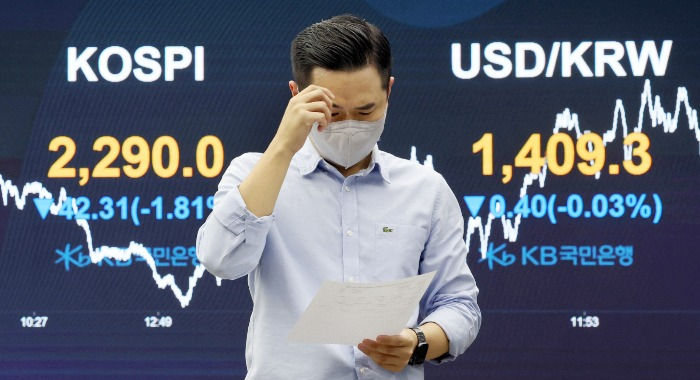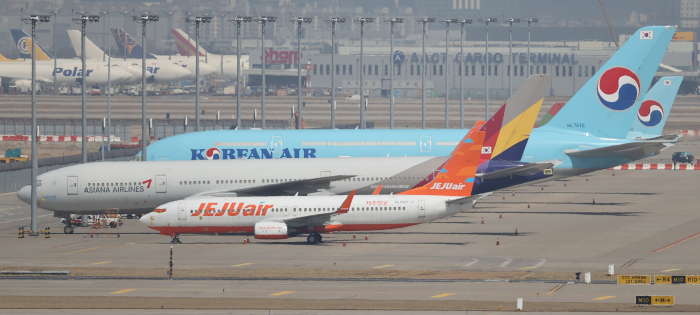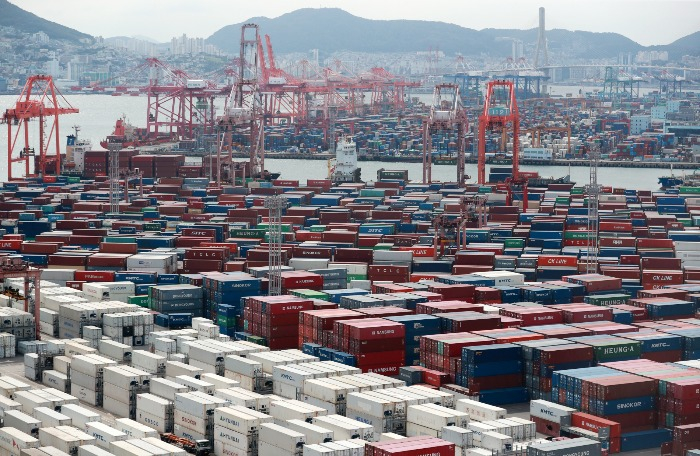Corporate strategy
Weaker won offers no leg up for Korean exporters
As won hits weakest level in over 13 years, cost cuts are likely to become a top priority for Korean companies in 2023
By Sep 23, 2022 (Gmt+09:00)
5
Min read
Most Read
LG Chem to sell water filter business to Glenwood PE for $692 million


Kyobo Life poised to buy Japan’s SBI Group-owned savings bank


KT&G eyes overseas M&A after rejecting activist fund's offer


StockX in merger talks with Naver’s online reseller Kream


Mirae Asset to be named Korea Post’s core real estate fund operator



The steeper-than-expected decline in the won’s value is posing a grave threat to South Korean companies already struggling with rising inflation and higher interest rates.
A softening won used to support Korean exporters such as Samsung Electronics Co., SK Hynix Inc. and Hyundai Motor Co. by making their products cheaper overseas. It also boosts the converted value of their overseas sales, contributing to first-half profits of major Korean exporters.
But such benefits are now being outweighed by a surge in import costs accelerated by the cheaper local currency. Korean companies depend on imports of minerals and other raw materials to produce batteries, steel products and microchips.
The won is the worst-performing currency among emerging Asian economies this year. It has shed 16% of its value against the greenback so far this year, hitting its weakest level in over 13 and a half years.
The sharper-than-expected depreciation of the won is also pushing debt servicing costs up sharply, particularly for airlines, exacerbated by subdued consumer demand and a looming economic slowdown.
Further, a decline in its competing currencies' value undermines the price competitiveness of Korean companies.
“A rise in the dollar-won rate tended to raise exporters’ profitability. But that theory no longer works,” an electronics company official told The Korea Economic Daily on Friday. “We’re stuck in a quandary.”
In the face of the sharp fluctuations of the dollar-won rate, Korean companies are scurrying to revise their business plans for the fourth quarter and into next year.
“We may shift our management focus toward cost cuts next year,” said a Korean company official.
Some foreign exchange dealers cautioned that the won could test the 1,500 won mark against the dollar, after it breached the psychologically important level of 1,400 per dollar for the first time since 2019 on Thursday.

DEBT FOR AIRLINES
The won’s weakness has been taking a heavy toll on airlines such as Korean Air Lines Co. and Asiana Airlines Inc. They lease aircraft, for which they borrow money from abroad.
If the won depreciates by about one-tenth per dollar, foreign currency losses per quarter are estimated at 350 billion won ($250 million) for Korean Air and 284 billion won for Asiana, based on the second-quarter exchange rate.
Asiana, with a debt-to-equity ratio of 6,544.6% as of end-June, reported foreign currency losses of 416.3 billion won in the first half of this year.
The figure is more than double the 198.3 billion won it booked as foreign currency-related losses in the same period a year earlier. The country’s No. 2 airline is saddled with 4.9 trillion won in foreign currency debt as of end-June.
RAW MATERIALS COSTS
Samsung, the world’s top memory chip and smartphone maker, suffered a 24.6% surge of its first-half raw materials expenses from a year earlier. At LG Electronics Inc., raw materials costs climbed 17.8% over the same period.
“Given the slowing economy and dwindling global demand, we may not be able to fully pass rising raw materials prices to consumers,” said a business group official. “We need to promptly revise our fourth-quarter plans and strategy.”
LG Energy Solution Ltd., a leading rechargeable battery maker, was hit by a near doubling of cathode material prices, to $42.37 per ton in the first half over the previous year.
Lotte Chemical Corp. saw the import prices of naphtha, a feedstock of petrochemical products, soar 41% on-year to $863 per ton in the second quarter.
Iron ore prices for steelmaker POSCO Co. have leapt 31.2% to $126 per ton as of end-June compared with the start of this year.

BENEFITS OF THE WON’S WEAKNESS
Foreign exchange gains lifted SK Hynix’s second-quarter operating profit by more than 400 billion won and its sales by 500 billion won, according to the company. For Hyundai Motor, foreign currency gains amounted to 641 billion won in the second quarter of this year.
In the second quarter, the won lost 12.4% of its value against the dollar versus the same period a year earlier. The currency decreased another 15.1% per dollar in the third quarter as of Sept. 23.
Based on these figures, Hyundai Motor is estimated to have pocketed 787.1 billion won in exchange rate-related gains in the current third quarter.
According to the Korea International Trade Association (KITA), a 10% depreciation in the won to the dollar is estimated to lift operating profit margins of Korea machinery and device exporters by 3.5 percentage points, automakers by 2.5 percentage points and chemical products makers by 1.4 percentage points, based on 2019 Bank of Korea data.
But foreign currency gains are unlikely to continue to shore up their earnings since top Korean manufacturers have moved an increased number of their plants abroad.
Among Samsung Electronics’ 32 production facilities, 26 are overseas and together account for 81.3% of its output.
LG Electronics operates 25 of its 30 factories overseas, which represent nearly 84% of the company’s total production.
Moreover, the depreciation of the won's competing currencies such as the Japanese yen will likely undermine any benefits of the weakening won. Korean car and chipmakers compete head-on with Japanese rivals in overseas markets.
GAMING PLATFORMS
On the flip side, gaming companies heavily reliant on overseas users are expected to enjoy the weakening won for a longer period of time. The weaker currency raises the converted value of their overseas revenue.
Netmarble Corp., Krafton Inc., and Pearl Abyss Corp. generate more than 80% of their revenue from abroad.
Write to Sang-Eun Lee, Kyung-Min Kang and Ji-Eun Jeong at selee@hankyung.com
Yeonhee Kim edited this article
More to Read
-
 Foreign exchangeKorea FX authorities, NPS agree on currency swap; won flat
Foreign exchangeKorea FX authorities, NPS agree on currency swap; won flatSep 23, 2022 (Gmt+09:00)
3 Min read -
 Foreign exchangeKorean won rebounds on estimated $2 bn intervention
Foreign exchangeKorean won rebounds on estimated $2 bn interventionSep 16, 2022 (Gmt+09:00)
2 Min read -
 Central bankBOK chief signals another big step as Fed hike haunts won
Central bankBOK chief signals another big step as Fed hike haunts wonSep 22, 2022 (Gmt+09:00)
5 Min read -
 Corporate strategySK’s Chey says survival is now top priority over profits
Corporate strategySK’s Chey says survival is now top priority over profitsSep 22, 2022 (Gmt+09:00)
1 Min read -

Comment 0
LOG IN


